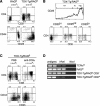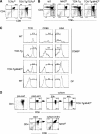TOX provides a link between calcineurin activation and CD8 lineage commitment
- PMID: 15078895
- PMCID: PMC2211890
- DOI: 10.1084/jem.20040051
TOX provides a link between calcineurin activation and CD8 lineage commitment
Abstract
T cell development is dependent on the integration of multiple signaling pathways, although few links between signaling cascades and downstream nuclear factors that play a role in thymocyte differentiation have been identified. We show here that expression of the HMG box protein TOX is sufficient to induce changes in coreceptor gene expression associated with beta-selection, including CD8 gene demethylation. TOX expression is also sufficient to initiate positive selection to the CD8 lineage in the absence of MHC-TCR interactions. TOX-mediated positive selection is associated with up-regulation of Runx3, implicating CD4 silencing in the process. Interestingly, a strong T cell receptor-mediated signal can modify this cell fate. We further demonstrate that up-regulation of TOX in double positive thymocytes is calcineurin dependent, linking this critical signaling pathway to nuclear changes during positive selection.
Figures





Similar articles
-
Opposite CD4/CD8 lineage decisions of CD4+8+ mouse and rat thymocytes to equivalent triggering signals: correlation with thymic expression of a truncated CD8 alpha chain in mice but not rats.J Immunol. 1998 Jan 15;160(2):700-7. J Immunol. 1998. PMID: 9551905
-
Duration of TCR signaling controls CD4-CD8 lineage differentiation in vivo.Nat Immunol. 2004 Mar;5(3):280-8. doi: 10.1038/ni1040. Epub 2004 Feb 8. Nat Immunol. 2004. PMID: 14770180
-
TOX: an HMG box protein implicated in the regulation of thymocyte selection.Nat Immunol. 2002 Mar;3(3):272-80. doi: 10.1038/ni767. Epub 2002 Feb 19. Nat Immunol. 2002. PMID: 11850626
-
Receptor signals and nuclear events in CD4 and CD8 T cell lineage commitment.Curr Opin Immunol. 2005 Apr;17(2):116-21. doi: 10.1016/j.coi.2005.02.004. Curr Opin Immunol. 2005. PMID: 15766669 Review.
-
Commitment issues: linking positive selection signals and lineage diversification in the thymus.Immunol Rev. 2006 Feb;209:253-73. doi: 10.1111/j.0105-2896.2006.00345.x. Immunol Rev. 2006. PMID: 16448547 Review.
Cited by
-
Identification of Differentially Expressed Genes and Prediction of Expression Regulation Networks in Dysfunctional Endothelium.Genes (Basel). 2022 Aug 30;13(9):1563. doi: 10.3390/genes13091563. Genes (Basel). 2022. PMID: 36140731 Free PMC article.
-
BCL11B is required for positive selection and survival of double-positive thymocytes.J Exp Med. 2007 Nov 26;204(12):3003-15. doi: 10.1084/jem.20070863. Epub 2007 Nov 6. J Exp Med. 2007. PMID: 17998389 Free PMC article.
-
Lineage fate and intense debate: myths, models and mechanisms of CD4- versus CD8-lineage choice.Nat Rev Immunol. 2008 Oct;8(10):788-801. doi: 10.1038/nri2416. Nat Rev Immunol. 2008. PMID: 18802443 Free PMC article. Review.
-
New opportunities to overcome T cell dysfunction: the role of transcription factors and how to target them.Trends Biochem Sci. 2024 Nov;49(11):1014-1029. doi: 10.1016/j.tibs.2024.08.002. Epub 2024 Sep 13. Trends Biochem Sci. 2024. PMID: 39277450 Review.
-
Transcription factors involved in the regulation of natural killer cell development and function: an update.Front Immunol. 2012 Oct 15;3:319. doi: 10.3389/fimmu.2012.00319. eCollection 2012. Front Immunol. 2012. PMID: 23087693 Free PMC article.
References
-
- Starr, T.K., S.C. Jameson, and K.A. Hogquist. 2003. Positive and negative selection of T cells. Annu. Rev. Immunol. 21:139–176. - PubMed
-
- van Oers, N.S. 1999. T cell receptor-mediated signs and signals governing T cell development. Semin. Immunol. 11:227–237. - PubMed
-
- Kioussis, D., and W. Ellmeier. 2002. Chromatin and CD4, CD8A and CD8B gene expression during thymic differentiation. Nat. Rev. Immunol. 2:909–919. - PubMed
-
- Harker, N., T. Naito, M. Cortes, A. Hostert, S. Hirschberg, M. Tolaini, K. Roderick, K. Georgopoulos, and D. Kioussis. 2002. The CD8alpha gene locus is regulated by the Ikaros family of proteins. Mol. Cell. 10:1403–1415. - PubMed
-
- Taniuchi, I., M. Osato, T. Egawa, M.J. Sunshine, S.C. Bae, T. Komori, Y. Ito, and D.R. Littman. 2002. Differential requirements for Runx proteins in CD4 repression and epigenetic silencing during T lymphocyte development. Cell. 111:621–633. - PubMed
Publication types
MeSH terms
Substances
Grants and funding
LinkOut - more resources
Full Text Sources
Molecular Biology Databases
Research Materials

